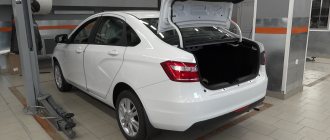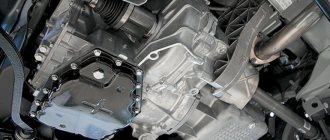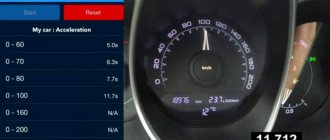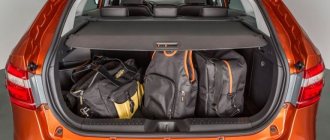Dimensions Lada Vesta
Trunk Lada Vesta
The new model of the domestic automobile industry quickly gained popularity due to its modern appearance and respectable size. The dimensions of the Lada Vesta correspond to cars in the intermediate B+ segment, noticeably exceeding the body dimensions of other AvtoVAZ models. Due to the increase in external parameters, the internal dimensions of the machine have changed in a positive direction.
dimensions
General dimensions, length and height of the cabin, seats
Clearance without load -175 mm. Under load 144-150 mm.
Overall (reference) dimensions of the LADA Vesta SE car
Overall (reference) dimensions of the LADA Vesta SW car
Overall (reference) dimensions of the LADA Vesta SW Cross car
Other dimensions (height of the cabin, passenger seat, distance between the backs of the front and rear seats, trunk opening, distance between the wheel axles, distance and angle of steering wheel adjustment, luggage capacity, distance from the rear seat to the trunk lid, distance from the ground to the bottom of the luggage compartment )
| L1, mm | H1, mm | B1, mm | H1mm | L2, mm | H2, mm | B2, mm | L3min/max, mm | H3, mm | B3, mm | Н4, mm | Vbag., l | B4, mm |
| 950/ 1125 | 1020 | 1400 | 1205 | 625/ 880 | 920 | 1355 | 955/1895 | 585 | 1010 | 465 | 436/ 480 | 975 |
| Н5, mm | M1, kg (%) | M2, kg (%) | M (M1+M2), kg | S°, deg./ S, mm | h, mm | h1, mm | D, mm | Wb, mm | Ah, mm | E, mm | Тп/Т3, mm |
| 720 | 734 (58,9) | 513 (41,1) | 1247 | 6,0/50 | 175* | 215 | 4410 | 2635 | 1497 | 1764 | 1510/ 1510 |
Measurements were taken by the magazine Behind the Wheel. Manufacturer's data is indicated in blue.
Viewing Angles
"Dead" (unviewable) zones
Trunk dimensions (sedan)
Trunk volume is 446 liters.
Video
Source
Exterior
The design of the exterior was a success, and few can argue with that. The front acquired aggressiveness thanks to the correct layout of the head optics and radiator grille. The headlights also did not disappoint: they fit well into the overall design and look good. On the side of the sedan there are stamped “boomerangs”, which some people don’t like, but without them the car would clearly lose its originality.
The rear view is also good: the headlights are partially moved to the trunk lid and are in contact with the side stamped, which looks very stylish. Much dissatisfaction among many was caused by the overly large gas tank hatch, which we can completely agree with: it could have been reduced or stylized into an oval shape.
I would also like to say about the lemon color, which has become Vesta’s signature. You will have to pay an additional 30 thousand for this coloring, but it is worth it. Also, the car suits cherry, black and even yellow, so car owners have a choice: overpay for an exclusive or be content with the standard, which is also, in general, not bad.
Interior width of Lada Vesta sedan
LADA Vesta (sedan, station wagon) is a Russian compact small car, produced by AvtoVAZ since 2015.
- Height from front seat to roof: from 939 (mm) to 990 (mm);
- Height from front rear to roof: 896 (mm).
Caution: The above data are the official figures of the manufacturer, however, please note that the information is for reference only and is not guaranteed to be completely accurate.
Source
Hatchback and liftback: what's the difference?
The abundance of car body types can make it difficult for a novice motorist to choose a car. In such a situation, you have to process large amounts of information in order to get to the bottom of it and, for example, understand how a liftback differs from a hatchback. Not all of these passenger cars, which are quite similar in many characteristics, will be able to quickly distinguish them in traffic.
Hatchback parameters This body type has been developed since the middle of the last century. Its name contains two English words “hatch” - hatch and “back” - rear.
In fact, this describes the presence of a door on the rear side of the car. This door is not used for boarding passengers, but for comfortable stowing luggage or cargo. Manufacturers offer both three-door and five-door hatchback models.
The main design solution is to combine the luggage area located at the rear with the passenger compartment into a single space. Thus, the result is a two-volume car, in contrast to a three-volume sedan.
A nice bonus for hatchback owners will be the presence of reduced rear overhangs, which not only makes parking better, but also makes it easier to maneuver in confined spaces.
Characteristic features include the presence of front-wheel drive and a transverse engine arrangement.
It is advisable to look at the hatchback and liftback from the side; you can see the difference between them from this angle. In a hatchback, the fifth door runs from the roof to the signal stops in a smooth line, without sharp bends. The profile of such a case is close to a teardrop shape.
Characteristics of a liftback The name of this type of car is a composite of two English words: lift - to lift and back - rear part. In some sources the name “liftback” is found. This type is included in the group of passenger cars and has a visual similarity to both sedans and hatchbacks.
The liftback is classified as a two-volume body type because its interior is combined with a luggage area. However, the space dimensions for suitcases and bags are larger here than in a similar hatchback class.
This is due to the increased overhangs at the rear, which also add internal volume.
Comparison with other models
The overall dimensions of the Lada Vesta consist of several parameters. The length of the Lada Vesta is 441 cm, which allows it to have sufficient space inside the car. The width of the Lada Vesta is also greater than that of other VAZ models. Thanks to this, passengers and the driver do not feel pinched in the shoulders. To really evaluate the advantages of the new sedan, it is enough to compare it with other domestic cars produced today by the AvtoVAZ plant:
| Technical information: | |||||||||||||||||||||||||||||||||||||||||||||||||||||||||||||||||||||||||||||||||||||||
Important: in all modifications of LADA Vesta, the internal door trim is a load-bearing part of the door structure due to the built-in armrest and side impact protection elements. Lada Vesta is a replacement for the LADA Priora family. Since 2022, it has been produced as a station wagon. Important: currently in production. | Salon min (mm) Minimum cabin width in (mm): Minimum interior width of Lada Vesta for different modifications Data are presented in millimeters (mm). | Salon max (mm) Maximum cabin width in (mm): Maximum interior width of Lada Vesta for different modifications Data are presented in millimeters (mm). | n Number of model modifications in our database.
In almost all respects, the dimensions of the Lada Vesta exceed those of its closest “relatives”. Compared to foreign cars, the new product from VAZ also looks appropriate. Its most popular competitors cannot boast of spaciousness inside:
According to the table, it can be seen that the ground clearance of AvtoVAZ’s new product is greater than that of foreign competitors, which means that the domestic car is more adapted to different types of road surfaces, including light off-road conditions. Ground clearance has three meanings:
In the vehicle data, the clearance corresponding to the first case is most often indicated. | ||||||||||||||||||||||||||||||||||||||||||||||||||||||||||||||||||||||||||||||||||||
Information about engines
Lada Vesta Cross 2020
The technical characteristics of the Lada Vesta in terms of the engine are not amazing, but they do not reduce the potential of the overall perception.
- The main engine of the Russian car is a power unit with a capacity of 106 horsepower and a volume of 1.6 liters. With such an internal combustion engine, the Lada Vesta reaches a maximum speed of 178 km/h and accelerates to 100 in 11.8 with manual transmission (12.8 with AMT). Fuel consumption is not low - 9.5 liters in an urban environment.
- To reduce the cost of the product, VAZ plans to install under the hood of the sedan an engine that is inferior in power to the VAZ 21116 (85 hp). This unit has the advantage of reliability, and many foreign manufacturers install it on their models.
- ICE 122/1.8 is the most powerful in the series, has a long service life (300,000 km), and also complies with Euro-5 standards. Planned for installation on Lada Vesta sports models.
- H4M-HR16 DE is a development of the Renault-Nissan Alliance, characterized by reliable operation. Instead of a timing belt, engineers built a chain here that practically does not fail and does not deform the valves. ICE 114l.s/1.6 l. It consumes a small amount of fuel, but due to its design it can produce good dynamics.
Interior dimensions
Dimensions of the Lada Vesta The solid size of the body of the Lada Vesta accommodates an equally spacious interior.
Five average-sized people can fit inside the car. The decent height of the Lada Vesta made it possible to increase the space between the seat cushions and the ceiling. Getting into the car is carried out at a comfortable level and there is no risk of hitting your head on the edges of the doorway. The distance from the rear wall of the front seat to the rear passenger's feet is more than 200 mm. A passenger up to 190 cm tall will not rest his knees on the back of the seat in front. The length of the front seat cushions and the rear sofa reaches 45 and 48 cm, respectively. The width of the cabin allows for comfortable seating of three passengers on the sofa in the back. These interior dimensions are close in value to the parameters of class C cars.
Let's sum it up
As we have found out, the overall dimensions of the popular domestic model LADA Vesta today are able to meet the needs of the most demanding customers. The car is equally suitable not only for family owners, but will also be a reliable work companion. It allows you to easily transport large luggage if you fold the back rows. Also, the carrying capacity will allow you to achieve some savings when transporting items. All these possibilities have become available due to the fact that the manufacturer has endowed this progressive model with dimensions that are respectable for its class.
The new model of the domestic automobile industry quickly gained popularity due to its modern appearance and respectable size. The dimensions of the Lada Vesta correspond to cars in the intermediate B+ segment, noticeably exceeding the body dimensions of other AvtoVAZ models. Due to the increase in external parameters, the internal dimensions of the machine have changed in a positive direction.
Benefits of the luggage compartment
The trunk of the Lada Vesta is also not inferior in terms of useful space to its “classmates”. The shapes of the body parts of the rear of the car form a wide opening in the luggage compartment. Its main parameters:
- height – 57 cm;
- length – 96 cm;
- length with the backrests of the rear sofa folded – 1.65 m;
- width – 1.4 m;
- loading height – 71.5 cm;
- volume – 450 liters, if the seats are folded – 1100 liters.
The dimensions of the sedan meet all the requirements and needs of most people, since it can easily fit the whole family or a group of friends, as well as quite large luggage. With the rear seats folded down, you can transport long and large items in the car, and the car’s solid carrying capacity will allow you to save a lot on the delivery of non-standard and heavy cargo.
Source
Gearboxes
AvtoVAZ has already managed to experiment with types of transmissions on the Lada Vesta and continues to do so. The first gearbox that the model was equipped with was Renault JH3. There is nothing bad to say about the box - it was expensive for the manufacturer. From these motives they created their own new manual transmission based on the Priorovskaya one. Vestas with a French transmission are not produced today; all cars are equipped with a five-speed VAZ-21807 with a reinforced main gear, new material for rubber parts and a gear ratio of 3.9 for an engine with a capacity of 106 horses, 4.2 for 21179.
In addition to mechanics, Vesta is equipped with a Russian-made automated transmission. This is the same manual transmission, but with an electronic clutch drive, automatic gear shift mechanism and other electronics. Five-speed transmission with a gear ratio of 3.9. Lada owners have different opinions about this box. One thing is clear - without the desire to win a race and frequent driving in mountainous areas, you can drive saving on gasoline, because with the AMT robot, consumption decreases.
Work is actively underway on a CVT for Vesta. They plan to install it on the car together with the Nissan HR16 engine. We also hear about the development of our own machine gun together with foreign partners. You shouldn't expect any new products in the next five years.
Note to car enthusiasts: dimensions of the Lada Vesta
According to owners' reviews, the car's capacity is comparable to representatives of the golf class - Ford Focus and Kia Sid. The front seats are comfortable, their shape (the best in its class) and upholstery are pleasing.
Serial production of the Lada Vesta compact sedan car began in September 2015. Already in 2022, the car became the best-selling car in Russia (108,364 units), displacing its predecessors - the flagship Priora and Granta. The Lada Vesta’s dimensions, exterior, and driving characteristics have become the subject of discussion on forums. Reviews from owners are positive, reserved or biased - from fans of foreign cars.
Add a comment Cancel reply
You must be logged in to post a comment.
Lada Vesta in the line of the domestic giant AvtoVAZ is a progressive and promising car. It is designed to replace the previously popular flagship Priora model on the assembly line. The manufacturer initially included considerable overall body dimensions in its new creation, which in its class can be regarded as an attempt to gain leadership.
Let us remind you that Lada Vesta is a product of joint activity between AvtoVAZ engineers and the world-famous Renault-Nissan concern. For this car, the developers did not spare technology and created a completely new platform, which will serve in the future to create various modifications of the model. Thanks to such a base, the Russian car began to look very attractive. It acquired genuine monumentality and balance, which could not be seen in previous models. This aspect was directly affected by the dimensions. Thanks to their increase, passengers became much more comfortable inside the cabin, again in comparison with previously created models, where the dimensions were more modest.
Dimensions of Lada Vesta
There are 6 modifications in the model range. Traditional domestic bodies (sedan, hatchback, station wagon) and creative foreign ones (cross, sport) are presented. In the future - a coupe.
Dimensions of Lada Vesta SV Cross and X-Ray. Photo source: https://www.drive2.ru/l/538198298486376010/
- Classic. The car is equipped with a driver's seat airbag and an on-board computer. There is also ESC stabilizer, electric power steering, and electric windows in the front doors.
- Comfort. In addition to standard equipment, “Comfort” has heated front seats, climate control, and rear parking sensors.
- Luxe. The model, whose price exceeds the “Classic” version by almost 200 thousand rubles, is distinguished by a rich “stuffing”: electric windows of the rear doors, PTF (fog lights), heated windshield, navigator, DD (rain sensor), alloy wheels, clutch actuator ( for robotic automatic transmissions). A touchscreen multimedia system is available at an additional cost.
- Exclusive. The developers continued to take care of safety: side airbags, Era-Glonass system, immobilizer, daytime running lights. During emergency braking, the hazard warning lights automatically turn on.
Length of Lada Vesta
This parameter is important to know in order to calculate the size of the garage and entrance gate.
The size is determined with a tape measure. Length is the distance from the most protruding point of the car's front bumper to the farthest part of the rear. The length of the Vesta sedan (L) is indicated in the operating instructions - a record 4410 mm. To check for skeptics: the car is placed on a level surface, plumb lines are attached to the protruding parts of the bumpers or a building level is applied, points are marked on the ground, and the distance between them is measured with a folding meter.
Reviews and comparisons of the lengths of the station wagon and cross body showed the identity of the standard sedan modification. The hatchback is shorter: 4250 mm.
Width of Vesta with and without mirrors
Russian GOST 22748-77 defines the width (W) of a car as “... the distance between two planes of the vehicle, parallel to the longitudinal median and tangent to the vehicle on each side.” That is, all protruding parts of the car (wheel hubs, sills, door handles) are located between these parallel planes. But this does not include rear-view mirrors, side marker lights, flexible mud flaps, or swollen tires.
Dimensions Vesta SW. Photo source: https://dricar.ru/topic2994.html
- with mirrors – 2039 mm;
- without them - 1764 mm.
The distance between the right and left wheel arches, which many drivers consider to be wide, in hatchbacks, sedans and station wagons is 1680 mm.
Other standard modification parameters:
- ground clearance - 178 mm (under the engine crankcase);
- wheelbase – 2635 mm;
- front track – 1500 mm, rear – 1510 mm.
Ground clearance in Lada Vesta SW is 203 mm. Overall dimensions allow Vesta to compete with higher class cars.
Height of Vesta
This size is determined from the ground level to the upper plane of the roof, excluding the antenna and roof rails. According to AvtoVAZ, the height of the Vesta sedan is 1512 mm. According to the measurements of Autoreview journalists - 1497 mm. The difference can be explained by overinflated tires or vehicle equipment.
Body
Vesta is presented in two classes: station wagon and sedan. The dimensions of the Lada Vesta station wagon and Cross are different - the SV Cross is taller, longer and wider than its predecessor, although the wheelbase is the same - 2635 mm. The sedan has the same base.
The technical characteristics of the Lada vesta in the basic version are similar to those of the Lada SV. The rear wheel track of the 2180 sedan and SW is 1510 mm, the same as the front. SW Cross track - 1524 mm. The ground clearance for the former is 178 mm, for the Cross it is 203.
In all modifications, the Lada has a 4 x 2 wheel arrangement with front drive wheels. There are no all-wheel drive or rear-wheel drive vehicles. The engine is located in front across the engine compartment. The trunk volume for a passenger car is 480 liters. The cargo version has been increased to 825. The number of passenger seats in the sedan is 4, in the station wagon 5.
The external performance characteristics of the cars are different. The body dimensions of a simple station wagon are 4,410 meters long, 1,764 meters wide and 1,512 meters high
u. The width and length of the Lada Vesta sedan are the same, but the height is smaller, at 1.497 m. The length of the Vesta SV Cross is 4.424 m, height is 1.532 m, width is 1.785 m.
Vesta interior dimensions
External parameters also determine the internal volume of the car - the size of the Lada Vesta's interior. The long, roomy body allows you to transport 5 people of average build.
Trunk of Lada Vesta. Photo source: https://autospot.ru/brands/lada/vesta_sw/wagon/
Main parameters of the salon:
- height from the front (front) seat cushion to the ceiling – from 939 to 990 mm, cushion length – 450 mm;
- height from the rear passenger seat cushion to the ceiling – 896 mm, cushion length – 480 mm;
- the distance from the backs of the front seats to the feet of the rear passengers is 226 mm.
The interior decoration is attractive and ergonomic. The upholstery uses fabric, leatherette (in “Classic” and “Comfort” versions), leather (“Lux”).
Cargo capabilities
As for the cargo parameters, they are identical to the base or concept station wagon. In its standard position, the boot can accommodate 480 liters of cargo volume, with 95 liters of additional cargo space available under the false floor.
If you fold the two parts of the rear sofa, which has a division in the proportion of 1 to 2 seats, the cargo potential increases to 825 liters. However, due to the peculiarity that the front row of seats has a special panel between them, a flat surface of the floor of the cargo compartment is not possible.
Other sizing options
As for what size wheel rims, as well as what size tires, the size of tires and wheels, depending on the configuration, they can be different. In particular, the tire size can be either a maximum of 17 or an average of 16 inches, and there can also be a tire size of 15.
The same applies to such a parameter as the size of the wheels, or rather the size of the rims - they are all light alloy and correspond to the already specified rubber parameters.
From “shoes” let’s move quickly to characteristics that are of interest to “nauseous” people, for example, the size of the windshield wipers. The size of the wipers for the driver is 60 cm, and for the passenger - 45 cm. There are no complaints in the reviews about the work of the wipers from the factory, however, there are experimenters who set the brush sizes to 61 and 48 cm, respectively, for the driver and passenger.
Check out our group.
Vesta trunk dimensions
In 2022, AvtoVAZ plans to continue the Vesta line - the X-Ray Cross with a liftback body type. The rear overhang of the car will not be vertical, but in the form of a sloping slope, smoothly turning into the trunk. Car owners have already appreciated the advantage of this configuration of the cargo compartment. Folding the seats increases the vehicle's capacity. In normal condition, the trunk volume is 480 liters. If you fold the rear sofas flush with the floor, the compartment increases to 760 liters.
Only in the basic versions of the first generation Lada Vesta did the trunks have a capacity of 250 liters. Starting with the “Comfort” version, the compartment was increased to 480 liters, and in the station wagon – to 500 liters.
Trunk dimensions. Photo source: https://www.drive2.ru/l/488722749137617260/
Comparison with its predecessors: the Granta sedan is 40 liters ahead of the Vesta in terms of trunk volume. The Kalina station wagon lags far behind - 350 hp.
The weight of the Lada Vesta without the regulatory load is 1150 kg. With technical fluids and cargo, the vehicle weight reaches 1670 kg.
Attractive appearance
"Lada Vesta" is one of the few domestic cars that have a truly eye-catching appearance. Stampings on the body and doors, an aggressive radiator grille - all this and much more looks great. Although the car's optics cannot boast of LED lamps or any other devices, they are made with high quality and illuminate the path in the dark just fine.
The basic configuration is equipped with 15-inch stampings, and the maximum configuration is equipped with 16-inch castings. Although this car also fits 17-inch wheels, which look simply gorgeous. The taillights turned out to be quite large, but they fit perfectly into the exterior. In general, the car has a classic appearance for a sedan, except for the stampings on the doors that go onto the body. The same applies to the hood, which also has ribbing.
Comparison with competitors
The Lada Vesta, which took first place in sales in 2022, has many rivals. Domestic cars are compared with a number of foreign brands.
Hyundai Solaris
The Korean-designed sedan is assembled on assembly lines in St. Petersburg. Gasoline engine, two types of transmission and ground clearance lower than that of the Lada Vesta - 16 cm.
External dimensions: LxWxH (in mm) – 4405×1729×1470. Trunk volume - 370-480 l - depends on the configuration.
For comparison: the dimensions of the 2022 Lada Vesta station wagon are 4410x1764x1512 mm.
Hyundai Solaris lags behind the sales leader by almost 40 thousand cars per year.
Volkswagen Polo
The Kaluga front-wheel drive competitor is inferior in sales and size to the Lada Vesta sedan. The configurations of the cars are approximately the same.
Kia Rio
The five-seater family "Korean" - the main rival of the Lada Vesta - is produced in St. Petersburg in sedan and hatchback bodies. Ground clearance in basic models is 160 mm, in the X-Line modification - 195 mm.
External dimensions: 4400x1740x1470 mm.
In terms of the number of cars sold, Kia Rio lags behind Lada Vesta by 5 thousand units.
Lada Granta
Although the cars are the same width, they are not similar in appearance when viewed from the front. "Grant" is 142 mm shorter and 3 mm taller than "Vesta". Ground clearance – 180 mm.
Specifications
Power unit
The Lada Vesta has 3 power units. Moreover, the designers provided only gasoline options. They are presented as simple atmospheric ones, which are equipped with injectors and distributed fuel injection.
They have a volume of 1.6 liters, but their power is far from the same. So, there is a 16-valve engine with 106 horsepower and also a 16-valve engine with 114 horsepower.
It is interesting that these two units were developed by AvtoVAZ, but the third engine comes from Renault-Nissan. It is clear that the extraordinary design will affect the power limit, although for now this information is kept secret.
It is only indicated that the new Vesta car will reach the first hundred kilometers in 10.3 seconds, only 0.2 seconds faster.
than a VAZ 2110 with a two-liter engine, and its top speed will be 185 km/h. Specifications
| Engine | engine's type | Engine capacity | Power | Transmission | Acceleration up to 100 km/h, sec. | Maximum speed km/h |
| Lada Vesta 1.6 MT | Petrol | 1596 cm³ | 106 hp | Mechanical 5st. | 11.8 | 178 |
| Lada Vesta 1.6 AMT | Petrol | 1596 cm³ | 106 hp | Robotic 5st. | 12.8 | 178 |
Transmission
In its luggage, the Lada has a 5-speed manual gearbox, which is designed for engines with 114 horses. The robotic gearbox will be paired with a 106-horsepower engine.
Promising pendant
The car is built on a completely new suspension platform, which included a 5-degree caster and L-shaped arms with fixed steering knuckles. This suspension is installed on a subframe; the engine support points will also be installed on the subframe.
Moreover, on the same subframe there will be an electric power steering column from Renault Megane. By the way, all the steering and independent suspension were borrowed from the Renault Megane RS.
This suspension has improved characteristics than what was previously used on the Lada for decades. In general, the car contains parts of French and Japanese origin, however, in general, the Lada is assembled on a unique base.
If the car is heavily loaded, the ground clearance will not be greatly reduced. The thresholds and bottom were covered with special content, which is designed to protect against gravel and stone on road sections.
Dimensions
What are the dimensions of Lada Vesta? The new car measures 4,400 millimeters in length, 1,765 millimeters in width, and 1,498 millimeters in height. The car weighs 1190 kilograms.
General information about modifications
Today it is known that the new sedan will be sold in 3 main modifications:
- Classic;
- Comfort;
- Luxury
So far, these are only the main configurations, but the Russian company has decided to brush aside the template variations and switch to a selectable equipment list policy, which has made it possible to increase the number of selectable modifications several times, which now number 12 units.
This is a very thoughtful move, because then it will be possible to choose a car for any person with his wishes and tastes. Now the cost of the new product is known. For the standard Classic equipment you will need to pay from 514,000 rubles.
Original functionality
As mentioned, the Lada Vesta sedan comes with ERA-GLONASS, a crash box that is integrated into the car’s bumper, a multifunctional steering wheel with various adjustments, and a rear view camera with an image displayed on the display. There are also automated technologies that are responsible for closing the doors when starting on the road, opening them and turning on the emergency lights when the AirBag is fired.
Safety
In the “Lux” configuration, passive safety consists of 4 AirBags, and there will also be side airbags. On cheaper trim levels there will be 1 or 2 AirBags. A Russian-assembled car must pass a crash test as a class leader - 4 stars.
Active safety includes the ABS+ESC Bosch complex of the latest generation, even in the starting version. In the summer of 2015, a Bosch enterprise was launched in Samara, which will begin production of ABS and ISK for Lada.
Equipment and options
Equipment – Standard
Price: 446,900 rubles Engine and gearbox: 1.6 87 hp, MT
The basic standard version is modestly equipped with 14-inch wheels, a 12-volt socket, airbags, child seat mounts and a cabin air filter.
Equipment – Classic
Price: 480,500 rubles Engine and gearbox: 1.6 87 hp, MT Version Lada Granta Station Wagon Classic, in addition to the standard, is equipped with an on-board computer, electric power steering, electric windows for front doors, gear shift prompt, hubcaps, etc. (see details)
Version - Classic Optima
Price: from 506,500 rubles Engine and gearbox: 1.6 87 hp and 1.6 106 hp, MT and AMT Lada Granta Universal 2022 in the Classic Optima configuration, quite well equipped, has: air conditioning, heated exterior mirrors, rear seat folds out into ratio 60/40.
Equipment – Comfort
Price: from 526,500 rubles Engine and gearbox: 1.6 87 hp and 1.6 106 hp, 1.6 98 hp AT, MT and AMT Granta Universal in the comfort modification is equipped, in addition to other modifications, with an audio system with Bluetooth, USB, Hands free , FM and SD card, side door moldings, side mirrors with turn signal indicator and door handles in body color.
Lada Granta Station Wagon Luxe
Price: from 563,800 rubles Engine and gearbox: 1.6 87 hp and 1.6 106 hp, 1.6 98 hp AT, MT and AMT Luxury equipment is equipped with fog lights, climate control, driver's seat adjustment, heated windshield, light tinting of windows, etc. (full list when choosing engines (buttons below))
Lada Granta Station Wagon Luxe Prestige
Price: from 597,800 rubles Engine and gearbox: 1.6 87 hp and 1.6 106 hp, 1.6 98 hp AT, MT and AMT Top-end Luxury Prestige equipment is equipped with heated front seats, parking sensors (parking sensors), rain sensor and lights, etc. (full list when choosing motors (buttons below))
Color spectrum
When buying a car, among the many wishes for the car's configuration, the question arises: what color should I choose? And it’s not easy to answer. The Vesta Lada color scheme is represented by ten different shades, each of which is good in its own way. Of the entire range of colors, only one is represented by the usual two-layer enamel - glacial, the rest are so-called metallic. Each paint has its own individual code, indicating a specific place in the color palette. Representatives of AvtoVAZ have repeatedly stated about a possible increase in the variety of colors and shades. At the moment, Lada Vesta is available for sale in ten colors.
Lada Vesta body colors:
- phantom (496);
- glacial (221);
- black pearl (676);
- pluto (608);
- lime (366);
- krypton (372);
- Angkor (246);
- carnelian (195);
- platinum (691);
- blues (492).
All colors of Lada Vesta are presented on the official website of the model. The color names correspond to the specific color of the car. When choosing each of them, you can choose the option you like best. Photos of the Lada Vesta body color clearly demonstrate how the sedan will look in different colors. When choosing a specific color coating, you should consider its cost. Paint code 221 is offered free of charge. Lime looks the most unique and unlike other colors, so choosing it will cost the buyer 35 thousand rubles. This considerable amount is justified - such a car is impossible not to notice in a stream of other vehicles. For other metallized coatings you will have to pay another 12 thousand rubles to the total price of the car. When choosing paint on the AvtoVAZ website, photos in different colors change, which makes it easier to find a suitable option.
Phantom
The name of the coating speaks for itself - a smoky blue with a metallic sheen captivates with its twilight beauty. This category of paint goes well with the business-like appearance of the car. can be chosen by both a respectable person and a representative of the youth.
Glacial or classic white
This color is offered free of charge for any vehicle configuration. It is a snow-white enamel applied in two layers and does not have a metallic sheen. looks moderately bright and stylish. As a contrasting addition to this body shade, black alloy wheels and a roof are suitable, which will make the car look more sporty.
Black Pearl
One of the most popular car shades of all time is classic black. This color gives solidity to any car. has paint code 676. The pearl shine of the coating lives up to its name and makes others turn around at a passing car.
Cornelian
Carnelian color is the name of a natural stone that has a rich red or pink color. This is exactly what the representative of AvtoVAZ turned out to be. The rich shade of the body looks very expensive and beautiful. will not go unnoticed on the streets of a big city.
Platinum
Platinum color is one of the most popular among modern cars. It looks great in any lighting and, compared to other colors, it is less noticeable than dirt and dust. goes well with any wheels and accessories. This machine is designed for buyers of any age and gender.
Blues
The blues color, like the musical style, has a unique charm. The soft dark blue shade looks very beautiful and elegant. designed for people who are confident and know their worth.
The body color shades in which the Lada Vesta goes on sale are constantly updated. Their number in the future may reach twenty or more. Most body colors have a metallic effect, and this is an innovation and discovery for the Russian automobile industry. But besides this, Lada Vesta has many surprises in its painting and can surprise even completely skeptical people.
Currently, a new painting technology is used for Lada Vesta, using cataphoresis, which significantly strengthens the coating and therefore Lada Vesta is guaranteed to be protected from corrosion for six years from the date of purchase. This is an absolute innovation for AvtoVAZ, which deserves the status of a minor sensation.
Lada Vesta has only two body colors that do not fall under the “metallic” category. Three colors are the same as previous models, while the rest are new. Such a categorical change in the color scheme in the new model indicates a change in AvtoVAZ’s policy with the arrival of a new manager.
The main differences between a liftback and a hatchback
Both classes described above are modifications of passenger cars, similar in characteristics and driving performance to sedans from the same model range.
The differences between a liftback and a hatchback are as follows:
- The shape of the rear overhang, which makes the liftback look like a sedan;
- Door opening mechanism – on liftbacks, 2 alternative access methods can be provided;
- The liftback can be either two- or three-volume (which makes it even more similar to a sedan), while hatchbacks come only with two-volume.
It is worth noting that some manufacturers are not limited to this list, and regard the transition from a hatchback to a liftback as an opportunity for a comprehensive modernization of the series.
As an example, let's look at the Lada Granta liftback - along with a new body shape, the car received an upgraded brake system and chassis. These changes are not strictly tied to the body, and over time the domestic giant promises to transfer the innovations to the rest of the series.
For domestic consumers, both hatchbacks and liftbacks are of interest as cars for urban conditions, which are much more convenient than a sedan due to their dimensions and design solutions.
Sales of the Lada Granta liftback version have started in the country. At the same time, the new product received not only a fifth door, but also an updated design, an improved braking system, different suspension settings, and became more comfortable than a sedan. But, as Kolesa found out. Ru, most of the innovations will sooner or later migrate to it, so by and large we are talking about a comprehensive modernization of the model. But not so deep as to call it fundamental. However, judge for yourself...
"hatchback" viburnum
This full-fledged hatchback with 5 doors acts as a new version in the line of Kalinovsky modifications. The Kalina hatchback first appeared only in 2007, while Kalina has been produced since 1996. It is clear that drastic changes were made regarding the body, but the model also received other engines, more modern and meeting European toxicity standards.
The hatchback is ideal for passing city “traffic light” roads, as it is compact and equipped with an accurate power unit with ESVT. This ensures not only high speed characteristics, but also affects minimal fuel consumption.
The short body length (only 408 cm) helps the hatchback not only successfully maneuver among traffic, but also affects overall safety.
“Korotysh” can be called the most purchased “Kalinovskaya” model today, and this is not only a matter of novelty. Russian motorists have always liked hatchbacks, and this one is also equipped with the latest peak of auto fashion: a single key for locks, remote control. control, PU alarm and much more.
Shorty hatchback










